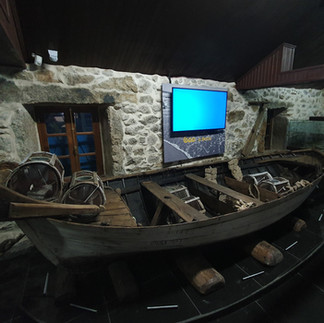Pepe do Cuco's hut houses the first automated museum in Galicia
- marialago67
- May 6, 2024
- 3 min read
In Spain there are hundreds, perhaps thousands, of historic buildings in which, with goodwill, large investments have been made in rehabilitation and museum facilities. The reality is that, a short time later, many of these sites are either closed or with a very precarious use regime. The main reason is usually the impossibility of providing them with adequate human resources for their opening, attention to the public or surveillance. Aware of this situation, the Carnota Council launched the first automated museum in Galicia through a grant from Galp Costa Sustainable.
Below we tell you in a little more detail about this small project of Pepe do Cuco's House:
THE HOUSE
The building where this small museum is located is due to Pepe do Cuco. It was built back in 1940 and recently given to the Carnota Council by its heirs. But Pepe didn't make it to live in, but to store and maintain the equipment and all the tools for "going to sea", being one of the many that were in Portocubelo, in the port of Lira. In Carnota, a large number of huts of this type are still preserved and in many cases they continue to fulfill their original function, among them a set of around 30 huts in Caldebarcos, at the other end of Carnota beach.
THE MUSEUM
The museographic project for the creation of this museum was based on respect for four principles:
-Regarding the speech and accent of the protagonists (the English and Spanish versions of the visit are simply subtitled).
-The way in which the inhabitants of Lira wanted to tell a story about themselves. In the booth there is no previous script, nor a narrator, nor an expository support where no expert conditioned the vision that his neighbors wanted to bring about Lira.
- The simple consolidation of the extremely deteriorated remains of an ethnographic collection in which the main element is a vessel, a boat.
- Minimal intervention in the Caseta itself for restoration purposes.
THE HISTORY
In a time not so distant, barely 80 years ago, at the time of Pepe do Cuco, life in places like Lira, Carnota or the Costa da Morte was very different from today, and could be very hard and difficult for many families. In those days, almost all the objects that had to be used on a daily basis were reduced to a little more than half a dozen materials: wood, stone, iron, clay, natural fibers and some others. With them they had to cope with all the daily needs and, of course, generate the tools and means to earn a living, such as ice boats and boats.
THE NARRATORS OF THE STORY
Inside the booth, through a series of screens, we tell a story that has to do with the people of Lira: Aurora, Rogelio, Anxo da Carreirana “O Peixe”, Abelardo, Lobelos, Jordi, Xaquín da Portuguesa are real people who have today an effective link with the seafaring culture. They bring us their vision of how life has evolved in Lira since Pepe do Cuco built his house, back in the 1940s. The testimonies of one and the other are shared by the presenter and virtual link Miguel de Lira, a prominent actor and also a neighbor of Lira.
THE USER EXPERIENCE
The Caseta de Pepe do Cuco proposes a completely new concept of relationship between the citizen and culture, in which there is no intermediary or limitation other than an automated access process called "Ymyk", an acronym for "Your mobile, your key" mobile, your key). Ymyk for the user consists of a QR code displayed on the outside of the Booth that leads to a simple access form in which the automatic opening of the door is requested. From here, a sequence of videos on different screens, sounds, lighting of objects and models narrate the story that the residents of Lira wanted to tell about themselves. The system, through lighting and sound, guides the visitor throughout the visit.










Comments